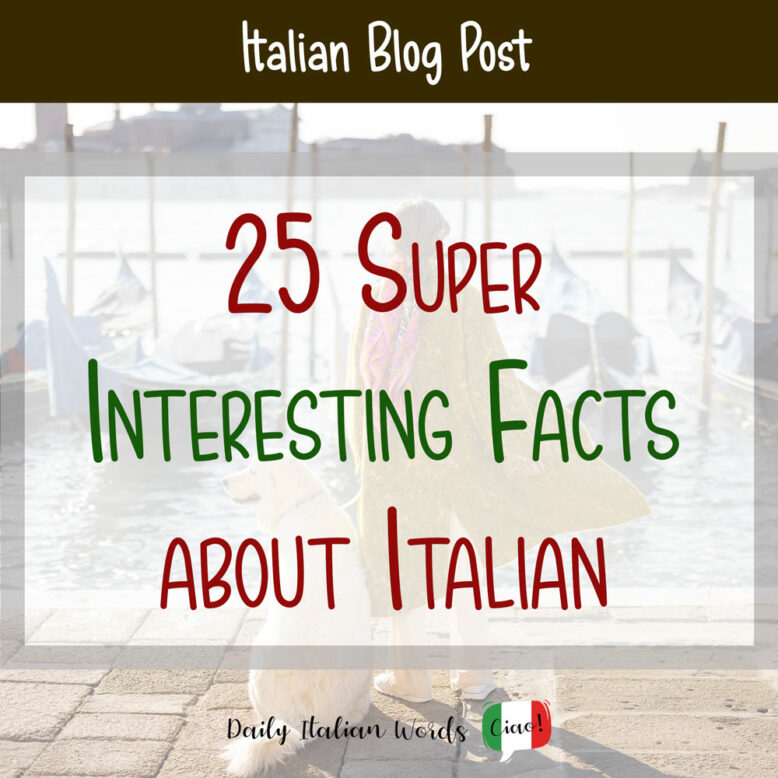You’ve got your grammar books lined up, your dictionary at the ready, and a burning desire to learn Italian – that’s great! But before you start, you may be interested to learn at least a handful of facts about the origins and history of the language. In this article, we’re offering up all the most interesting Italian language facts we’ve come across, some of which might surprise you!

Italian is spoken by over 63 million people worldwide
Ever wonder how many people speak Italian? According to Ethnologue, it is the 27th most spoken language worldwide. It is thought that at least 63 million people around the world speak Italian as their first language, with an additional 3 million claiming to speak Italian as a second language.
Italian has many unique words that aren’t easy to translate
Here are a few of our favourites!
- Abbiocco = a sudden bout of sleepiness after a hearty meal
- Spaghettata = a spaghetti meal eaten in good company
- Menefreghista = a person who doesn’t care
- Gattara = a woman who takes care of stray cats
Italian is a Romance language derived from Vulgar Latin
It is also the closest to Latin of all the Romance languages, followed by Spanish, Romanian and Portuguese. It shares 89% lexical similarity with French, 87% with Catalan, and 82% with Spanish.
Italy is home to many other dialects and languages besides Italian
This is because Italy didn’t exist as an independent country until 1861. Before then, Italy was a conglomerate of rival regions and city states, bound by a similar culture but linguistically speaking, fairly diverse.
By 1950, it was estimated that less than 20% of the Italian population spoke fluent Italian, and even today, many people feel more comfortable using a local language or dialect. Approximately half of all Italians speak a regional dialect as a mother tongue.
Note: Many so-called dialects such as Venetian and Neapolitan evolved separately from Latin and are mutually unintelligible. For this reason, linguists consider them separate languages rather than Italian dialects.
Standardised Italian spread thanks to television
The introduction of the television in the 1950s and 1960s played a vital role in the spread of standardised Italian and the subsequent displacement of local dialects and languages. In particular, a programmed entitled Non è mai troppo tardi (It’s never too late), which aired on Rai 1 in the 1960s, taught an estimated one and a half million illiterate people to read and write in Italian.
Did you know…?
In 2014, RAI produced a mini TV series to tell the story of Non è mai troppo tardi and the man who presented the show, professor Alberto Manzi.

Italian isn’t an official national language according to the Italian Constitution
You may be surprised to learn that the Constitution of the Italian Republic does not indicate Italian as an official language! Certainly it is the de facto language of the nation, due to it being spoken as a native tongue by approximately 93% of Italian people, but it has never been legally labelled a de jure national language despite a failed attempt in March 2007 to pass a law that would have given it said status. Some politicians are still asking for an amendment to the constitution to this day.
Interestingly, Italian is recognised as the official language in other state laws and official documents.
However Italian is the official language of many other countries
So where is Italian an official language? Four countries to be exact: the Republic of San Marino (which is actually a micro-state), southern Switzerland, four coastal municipalities of Slovenia and in the Istrian region of Croatia.
In the past, it was the official (or co-official) language of various geographical areas including Corsica until 1859, the Ionian Islands until 1864, Nice until 1870, the Principality of Monaco until 1919, and Malta until 1934.
And let’s not forget about the Vatican City where Italian is the official language used in internal communications and legislation. (The Holy See, on the other hand, uses Latin as its only official language.)
Italian was also the language of many former colonies
During colonisation in the 19th century, Italian was a primary language in Libya, Eritrea and Somalia.
In Libya, Italian was widespread until Muammar Gaddafi decreed Arabic to be the sole language permitted in official communications and on road signs. In Eritrea, its usage is mostly limited to commerce, yet it made a lasting impact on Tigrinya (the country’s main spoken language) due to the incorporation of numerous loanwords. Finally, in Somalia, it was the official language of administration and education until the Somali Civil War.
Italian is no longer one of the most widely spoken languages in America
Italian, along with many of the dialects and regional languages of Southern Italy, was once widely spoken in the United States due to large-scale immigration which began in the late 19th century.
However, due to numerous factors, including reduced immigration, assimilation into American society, and failure to pass the language down through the generations, the number of Italian speakers in the United States has fallen from nearly 1 million in 2001 to just half a million in 2017. Today these numbers are certainly even lower.
Italian is one of the most studied foreign languages in the world
According to a 2019 study published by Ethnologue, Italian rose from the fifth most studied language in the world to the fourth, preceded only by English, Spanish and Chinese. During the 2016-2017 academic year, it counted 2,145,093 students across 115 countries.

Italian is based on the Florentine dialect of Florence
Fiorentino (Florentine), the dialect of Florence, was the basis for what would become the Italian language. This was largely thanks to the works of Tuscan writer Dante Alighieri, whose poems, including the La Divina Commedia (The Divine Comedy), were read throughout the land by educated Italians.

The most famous and widely read Italian novel is ‘I Promessi Sposi’
The work of Alessandro Manzoni, I Promessi Sposi, known as The Betrothed in English, was first published in 1827 with a number of Lombard regionalisms but was later rewritten in standard literary Italian between 1840 and 1842. It is widely considered Italian literature’s first modern novel.
Other languages contain many Italian loanwords
In matters of music, art and cuisine, few outmatch the Italians! This is why so many Italian loanwords from these three spheres have been incorporated into other languages. We talk about these terms, plus many others, in our blog post about Italian words found in the English language.
And Italian has borrowed many words from other languages too!
In fact, some of these foreign terms have even replaced the Italian equivalent. A good example is the English word shopping which has largely substituted the Italian acquisti.
Interestingly, during the Second World War, the Fascists attempted to eliminate all foreign words from the Italian lexicon, as they were seen as “contaminations“.
And speaking of so-called contaminations, did you know that there is an academy focused on preserving the purity of Italian?
The Accademia della Crusca is a Florence-based society of scholars whose goal is twofold: to preserve and maintain the purity, and encourage the study and promotion of the Italian language. Founded in 1583, it is the oldest language academy in the world.
In 2015, the academy backed a petition called Dillo in Italiano (Say it in Italian). Its aim was to halt the increasing use of English words in Italian commerce and legislation. It gained over 70,000 signatories in just over a month.
Italian is considered the official “language of love”
In a Facebook poll hosted by CNN in 2014, Italian claimed the title of the language with the sexiest accent. But why is it that so many consider Italian the so-called “language of love”? According to Dr Patti Adank, Associate Professor of Speech, Hearing & Phonetic Sciences at University College London, the melodic nature of the language, or more specifically, the number of words ending in a vowel and the lack of consonant clusters, can be held responsible for its sensuality.

Italian has seven vowel sounds
And speaking of vowels, did you know that Italian has seven distinct vocalic phonemes represented by five letters (a, i, u, e and o)? (English by comparison has around twenty!)
What’s more, unlike English vowels whose orthography does not always represent the reality of their pronunciation, Italian vowels are almost always pronounced in the same way wherever they occur within a word.
The vowels are as follows:
[a]
Written as a
casa (house) – ancora (again) – anatra (duck)
Pronounced like the a in apple
[i]
Written as i
[u]
Written as u
uguale (same) – usare (to use) – uva (grapes)
Pronounced like the oo in boot
[ɛ]
Written as e
bello (handsome) – essere (to be) – finestra (window)
Pronounced like the e in bed
[o]
Written as o
fumo (smoke) – allegro (joyful) – mito (myth)
No equivalent in English. Similar to the o in no without rounding the lips at the end.
[ɔ]
Written as o
allora (well) – ancora (again) – fuoco (fire)
Pronounced like the a in walk
Nearly all Italian words end in a vowel
However some words, most of which are monosyllabic or borrowed from another language, do end in a consonant. Some good examples include:
- film (film)
- ananas (pineapple)
- camion (truck)
- nord (north)
- con (with)
- il (the)
- non (not)
- per (for)
Word-final consonants also occur as a result of apocope, or the omission of the final sound of a word. For example, bello becomes bel in front of certain masculine singular nouns (bel film = nice film).
Stress in Italian usually lies on the second-to-last syllable
But there are some exceptions such as words that have an acute (perché = because) or grave accent (caffè = coffee) or words with the stress on the third-to-last syllable (camion = truck, macchina = machine).
Italian spelling reflects the pronunciation
Unlike English whose pronunciation and spelling are annoyingly divergent, Italian has what is called a “shallow” orthography, meaning that the spelling is very regular with an almost one-to-one correspondence between letters and sounds.
There are of course some exceptions such as the letters c and g which may be soft or hard depending on the following letter. Each is soft when followed by e or i or hard when followed by one of the vowels a / o / u or a different consonant. For example:
- cielo (sky) > pronounced “cheh-low”
- casa (house) > pronounced “ka-za”
- giacca (jacket) > pronounced “ja-kka”
- gonna (skirt) > pronounced “goh-nna”
The Italian alphabet consists of 21 letters
Even though the letters j, k, w, y appear in loanwords (e.g. jeans, karaoke, etc.), they are usually excluded from the official Italian alphabet. Another letter that has become common in standard Italian is x, thanks to the prefix extra- and the Latin particle ex- (e.g. ex-Jugoslavia = Former Yugoslavia)
You can omit the subject in Italian
Unlike English, which always requires the subject to be explicitly stated, Italian is a null-subject language. This means you can omit the subject, particularly nominative pronouns, because the subject is indicated by verbal inflections. For example:
- (Lui) è gentile. = He is kind.
- (Noi) stiamo andando. = We are going.
Many famous Hollywood celebrities speak Italian very well
Some of the most well-known actors who speak Italian include:
- Colin Firth: Learned Italian for his wife, Livia Giuggioli, a director, producer and environmentalist. They have a home in Umbria.
- Audrey Hepburn: Spoke Italian, French, Spanish and Dutch from an early age.
- Ingrid Bergman: Lived in Italy and made five Italian language films with director and husband Roberto Rossellini.
- Jodie Foster: Studied Italian at university and has used it in films such as Il Casotto by Sergio Citti.
- Penélope Cruz: Learned Italian by working with director Sergio Castellitto on his films Non ti Muovere and Venuto al mondo.
- Vincent Cassel: Was married to Monica Bellucci for 14 years.
The longest word in Italian is 30 letters
The Welsh may have us all beat when it comes to long words, but Italian has a few gems of its own!
As of today, the longest word in the Italian dictionary is psiconeuroendocrinoimmunologia, which is a whopping 30 letters and 13 syllables.
Referring to the study of nervous, immune, and endocrine system functions, it admittedly isn’t the kind of word that arises in conversation every day, partly because it is often shorten to PNEI. Still, it’s worth remembering, if only to impress your Italian friends with your pronunciation skills!
Heather Broster is a graduate with honours in linguistics from the University of Western Ontario. She is an aspiring polyglot, proficient in English and Italian, as well as Japanese, Welsh, and French to varying degrees of fluency. Originally from Toronto, Heather has resided in various countries, notably Italy for a period of six years. Her primary focus lies in the fields of language acquisition, education, and bilingual instruction.



